Cash Flow Tools: Side-by-Side Comparison 2025
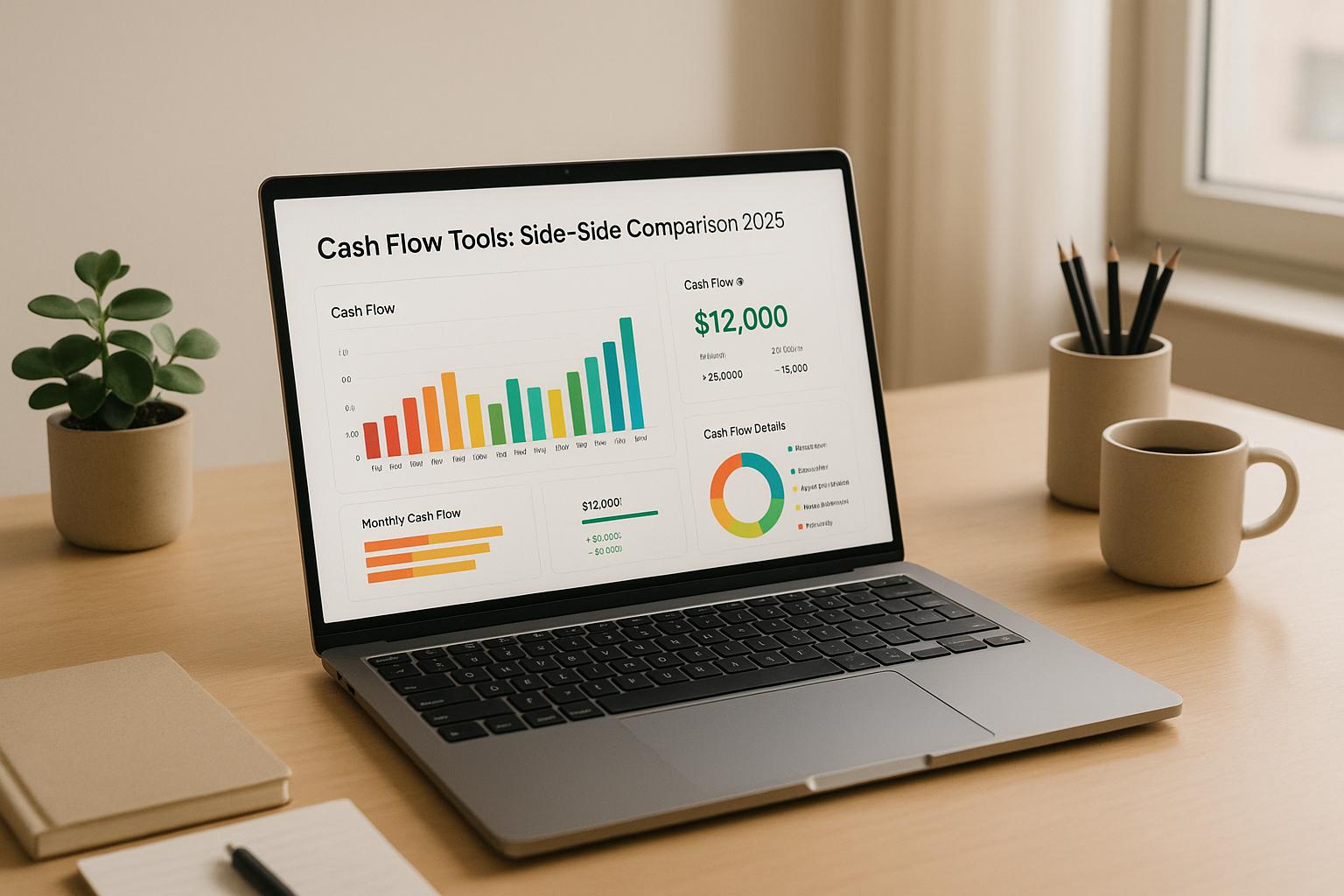
In 2025, cash flow forecasting tools are essential for businesses aiming to manage finances effectively. These tools go beyond spreadsheets, offering features like real-time data integration, scenario modeling, and automated reports. Whether you're preparing for funding rounds, managing growth, or planning exits, the right tool can help you stay on top of your cash flow.
Key Takeaways:
- Forecasting Features: Tools automate projections, reduce errors, and allow scenario analysis.
- Integrations: Sync with accounting platforms like QuickBooks and Xero for real-time updates.
- Ease of Use: User-friendly interfaces and mobile access simplify adoption.
- US Market Focus: Compliance with US standards and banking systems ensures reliability.
Top Tools for 2025:
- CashFlowFrog: Flexible forecasting, integrates with popular accounting tools, starts at $23/month.
- Savant: Connects to 200+ data sources, ideal for data-heavy businesses.
- Farseer: Advanced enterprise features, supports multi-entity and multi-currency forecasts.
- Float: Simple, affordable option for small businesses at $20/month.
- Finmark: Focused on high-growth companies, details limited.
Quick Comparison:
| Feature | CashFlowFrog | Savant | Farseer | Float | Finmark |
|---|---|---|---|---|---|
| Forecasting Automation | Real-time updates | Data blending | AI-driven | Syncs with accounting tools | Limited details |
| Key Integrations | QuickBooks, Xero, Sage Intacct | 200+ data sources | ERP, CRM, HR systems | QuickBooks, Xero | Limited details |
Choosing the right tool depends on your business size, complexity, and growth stage. Consider features like scalability, integration, and ease of use to find the best fit for your needs.
How We Evaluate Cash Flow Tools
When it comes to evaluating cash flow tools for US-based growth companies, we focus on three key areas that address the challenges businesses encounter during rapid expansion, funding rounds, or strategic transitions. These criteria emphasize practicality and seamless integrations, ensuring financial data stays accurate and up-to-date. Our approach digs deeper into each tool's capabilities, going beyond surface-level comparisons.
Forecasting Features
Automation plays a vital role in making cash flow forecasting both accurate and efficient. The best tools pull data directly from connected systems, updating projections in real time and minimizing the risk of human error. This eliminates the need for manual spreadsheet updates while offering a clear, moment-to-moment view of cash positions - a must-have during funding negotiations or strategic shifts.
Advanced features like scenario modeling let businesses explore multiple financial outcomes, while automated variance analysis pinpoints where actual performance deviates from projections. These capabilities empower companies to make informed decisions quickly.
Software Integrations
Seamless integration with existing systems is non-negotiable for effective cash flow management. Here’s what we look for:
- Accounting platform connectivity: Tools that sync effortlessly with popular US platforms like QuickBooks Online and Xero ensure invoices, bills, and transactions are always up to date.
- Payroll system integration: By connecting with payroll platforms, these tools automatically account for salary payments and related expenses, improving the accuracy of cash flow projections.
- Third-party app ecosystems: The ability to integrate with CRM systems, payment processors like Stripe, and e-commerce platforms such as Shopify adds flexibility and extends functionality.
Ease of Use
Adoption hinges on ease of use, and the best tools simplify every step:
- Guided setup: Step-by-step wizards streamline the configuration process, connecting accounting systems, importing historical data, and setting up forecasting parameters with minimal hassle.
- User-friendly design: Intuitive dashboards highlight key metrics, enabling users to spot trends and potential issues at a glance without being overwhelmed by data.
- Learning curve: Platforms that offer immediate value and accessible training help finance teams get up to speed quickly.
- Mobile accessibility: With flexible work arrangements becoming the norm, tools that provide full functionality through mobile apps or responsive web interfaces ensure finance teams can monitor and adjust cash flow projections from anywhere.
These evaluation criteria lay the groundwork for the detailed tool comparison featured later in the article.
Top Cash Flow Tools for 2025
Here’s a closer look at five tools that stand out in 2025 for their advanced features, seamless integrations, and intuitive design. These tools bring automation, real-time insights, and scenario modeling to the forefront, helping businesses stay on top of their cash flow.
CashFlowFrog
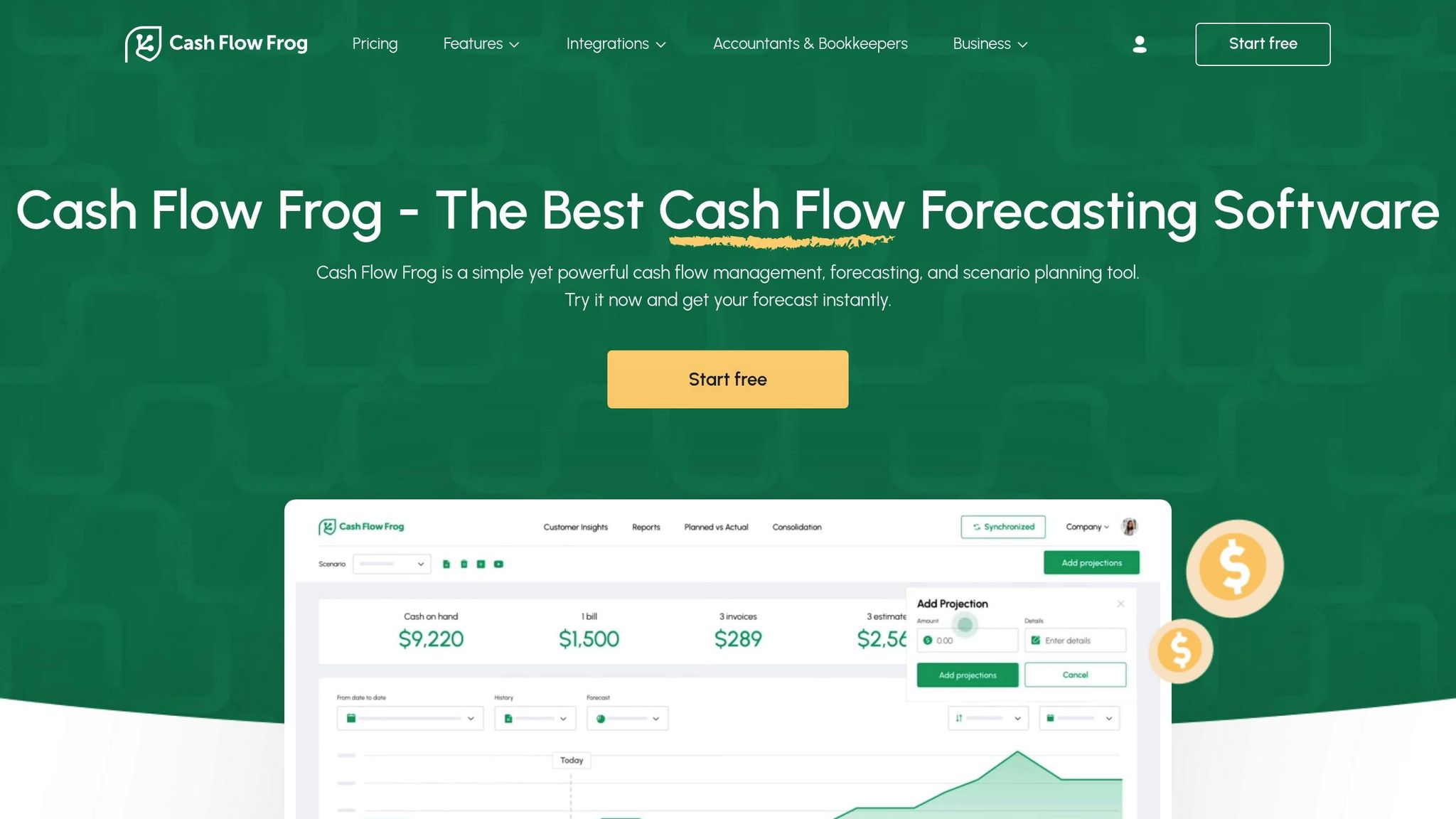
CashFlowFrog has earned its reputation on platforms like QuickBooks Marketplace and Capterra for simplifying cash flow management. By pulling data directly from accounting software, it eliminates the need for manual entry. The tool supports multi-period forecasting, offering daily, weekly, monthly, and quarterly projections for up to three years. This flexibility caters to both short-term needs and long-term planning. Features like what-if scenario analysis and planned vs. actual tracking make it easy to identify variances. It integrates with popular platforms like QuickBooks (all versions), Xero, FreshBooks, and Sage Intacct, and even supports entity consolidation. Pricing starts at $23/month (billed annually), with a basic plan at $29/month. A free trial and free version are also available for users to explore its functionality.
Savant
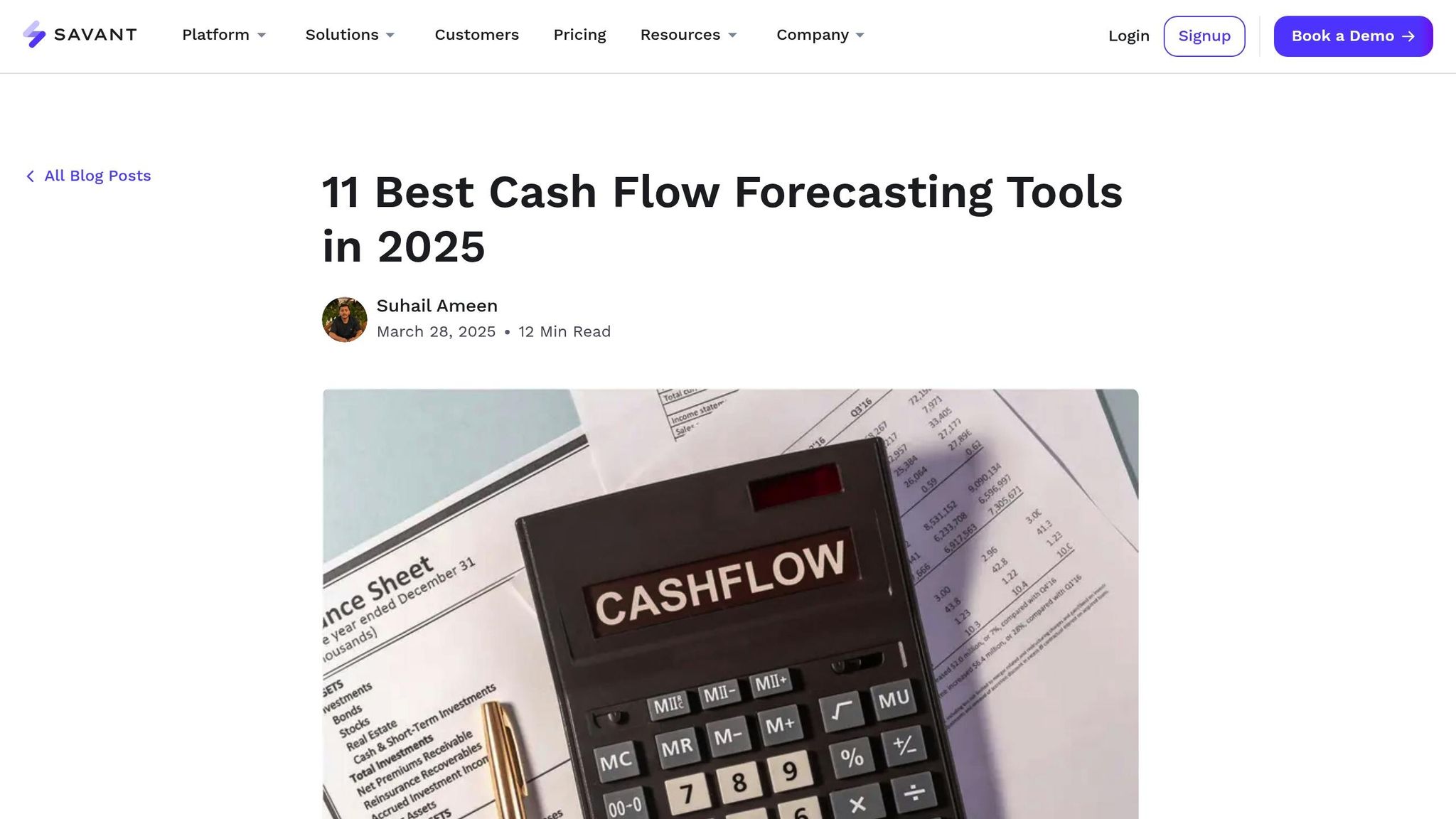
Savant stands out with its advanced data blending capabilities, connecting to over 200 data sources. This tool integrates effortlessly with major accounting platforms, making it ideal for businesses that rely on multiple systems to manage their operations. By consolidating cash flow data from diverse sources, Savant provides a comprehensive view of financial health.
Farseer

Farseer caters to enterprises with complex financial planning needs. Its fast calculation engine and spreadsheet-like interface make it user-friendly for finance professionals. The platform supports both direct and indirect cash flow methods and offers rolling forecasts and driver-based models for adaptive planning. With full 3-statement modeling, Farseer provides insights that go beyond basic cash flow management. It handles multi-entity and multi-currency forecasts and integrates with ERP, CRM, HR, and billing systems. Additional features like versioning and auditability ensure compliance with enterprise standards. Pricing starts at approximately $20,000 per year, with costs varying based on company size and required features.
Float
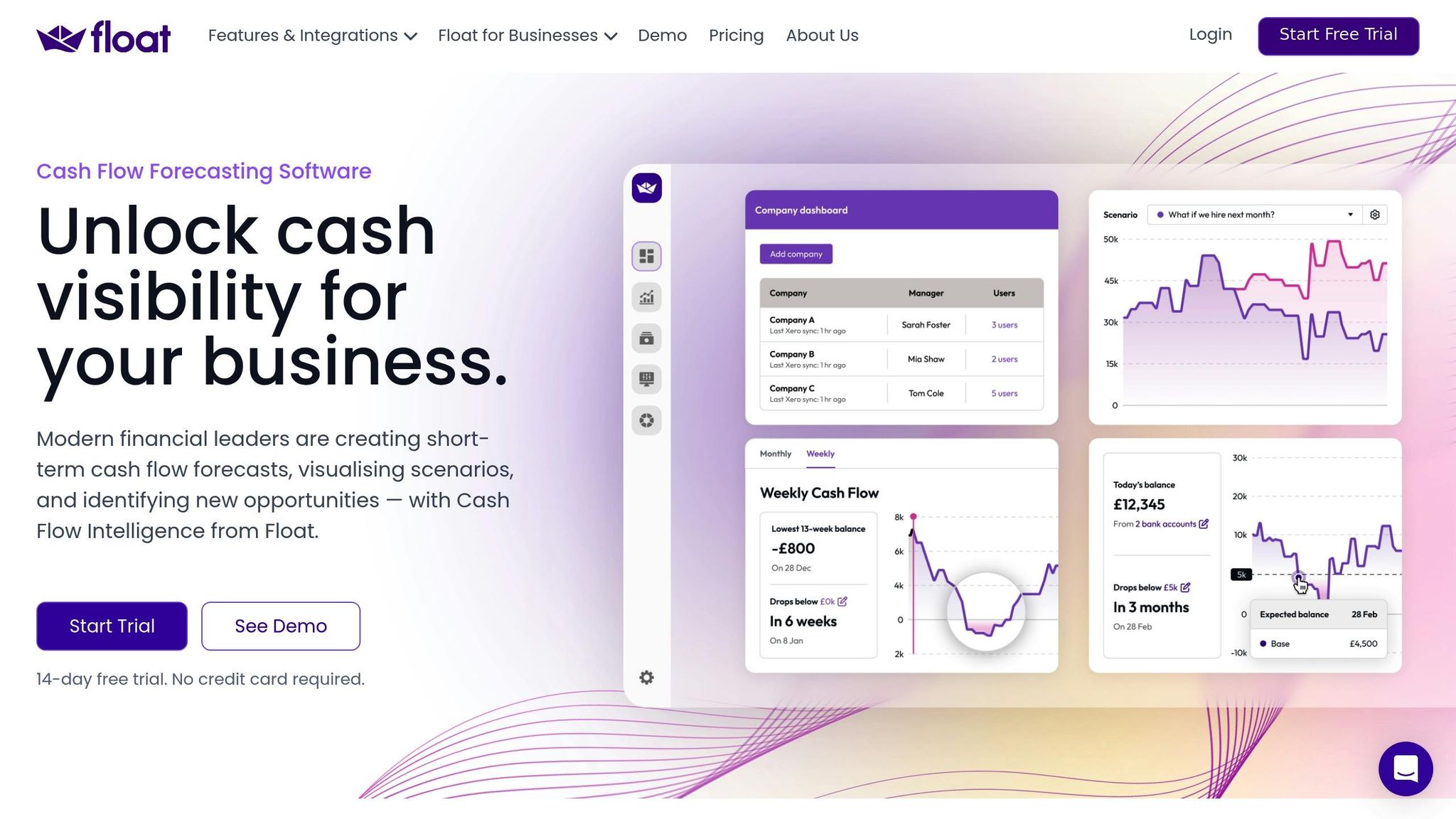
Float is designed for simplicity, making it a great choice for small and medium-sized businesses in the US. It syncs smoothly with major accounting platforms, ensuring data stays up to date without extra effort. Users can view cash flow data at different levels of detail - daily, weekly, or monthly - depending on their needs. At $20 per month, Float is an affordable option for businesses looking for straightforward cash flow management.
Finmark
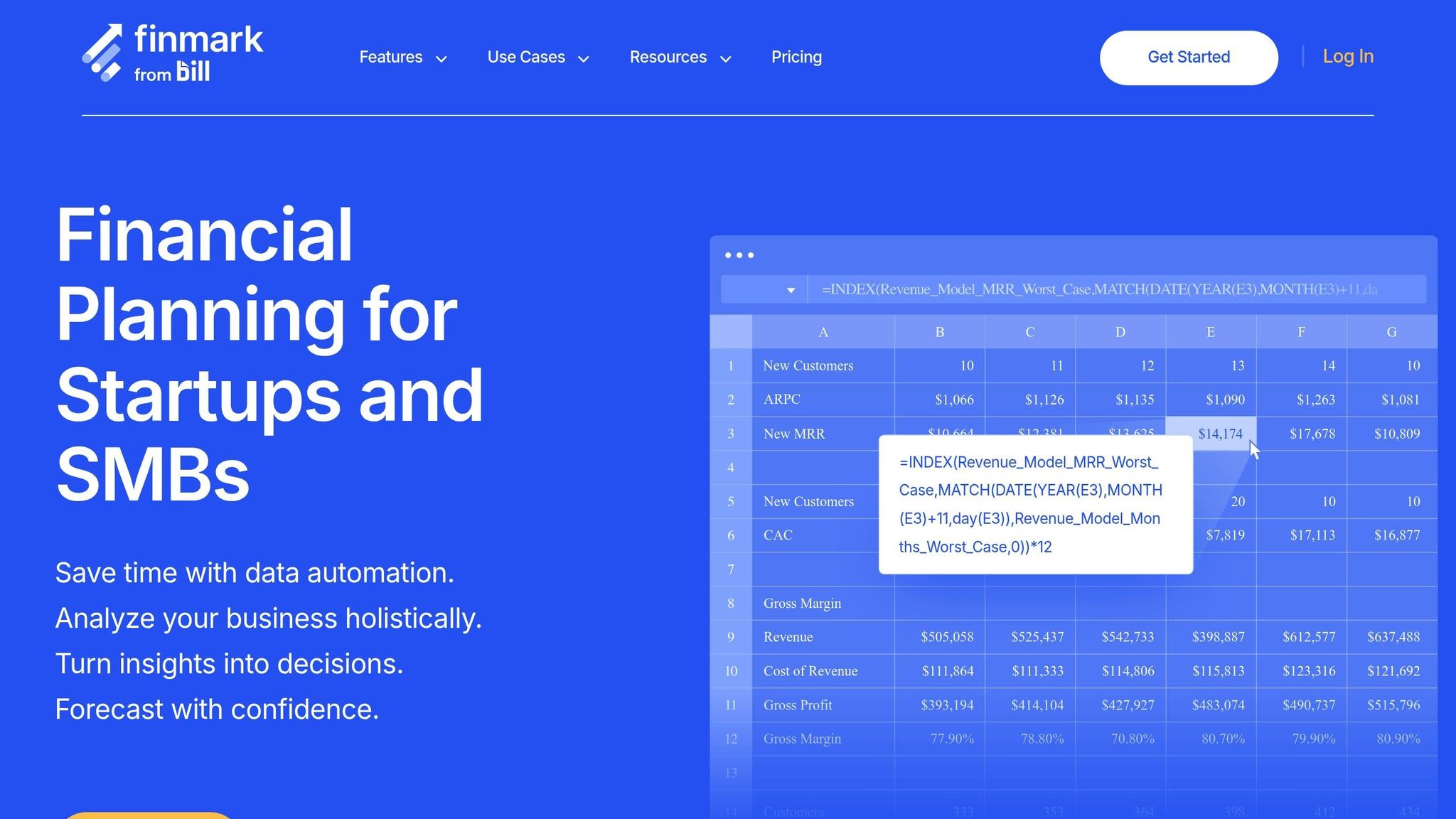
Finmark targets high-growth companies, though details about its features and pricing remain limited. As the platform develops, it’s expected to offer valuable tools for managing cash flow in fast-paced, growth-oriented environments.
Each of these tools addresses key needs in the US market, offering a mix of forecasting capabilities, strong integrations, and user-friendly functionality to help businesses thrive in 2025.
Side-by-Side Tool Comparison
Here's a breakdown of how these tools stack up against each other. Each platform offers a unique spin on automation and integrations, catering to different business needs.
| Feature | CashFlowFrog | Savant | Farseer | Float | Finmark |
|---|---|---|---|---|---|
| Forecasting Automation | Real-time updates pulled directly from accounting software, using algorithms for up-to-the-minute projections | Dynamic forecasting with automated filtering of invalid records and Gen-AI for workflow automation | AI-driven system automation to refine assumptions and identify anomalies | Syncs with accounting tools to create visual forecasts | Limited details available |
| Key Integrations | QuickBooks (all versions), Xero, FreshBooks, Sage Intacct, QuickBooks Desktop | Connects with over 200 data sources, enabling seamless data blending | Not specified | Xero, QuickBooks, FreeAgent | Limited details available |
Each platform brings its own strengths to the table. For example, Savant stands out with its ability to merge data from over 200 sources and build workflows using Gen-AI - no coding required. On the other hand, Farseer caters to enterprise users by automating financial data flows, refining assumptions, and flagging anomalies for better accuracy. Float keeps things straightforward, allowing users to add scenarios, projects, and budgets to visualize the impact of financial decisions.
This comparison helps you pinpoint the tool that aligns best with your business goals.
sbb-itb-e766981
How to Pick the Right Tool
Selecting the ideal cash flow forecasting tool is all about aligning it with your business needs and growth trajectory.
Which Features Matter Most
Scalability is key. As your business expands, your cash flow requirements will shift. Choose a tool that grows with you, adapting to evolving market conditions and operational demands without needing a complete overhaul.
Seamless integration with existing systems is another critical feature. This ensures accurate forecasts by eliminating data silos and providing a clear, comprehensive view of your cash position.
Predictive analytics and scenario planning capabilities are must-haves. Tools with features like AI-driven anomaly detection allow you to evaluate the potential impact of economic or operational changes, enabling smarter financial decisions.
Ease of use matters. A user-friendly interface encourages adoption across your team, while customizable options ensure the tool fits your workflows and reporting needs.
Consider the total cost of ownership. Look beyond the purchase price to factor in implementation, training, and ongoing costs. Weigh these against the benefits the tool is expected to deliver.
Accuracy and visibility are non-negotiable. Your tool should provide reliable data and a full picture of your operations, empowering timely and informed decisions.
These priorities, combined with earlier evaluation criteria, will help you choose a tool that meets your business's unique demands.
Getting More Value with Expert Help
Once you've identified the features you need, expert guidance can elevate your forecasting strategy even further. The best tools are only as effective as the strategy behind them, and this is where Phoenix Strategy Group can make a real difference.
Phoenix Strategy Group offers fractional CFO services tailored to help growth-stage businesses implement and optimize cash flow forecasting tools. Their team works closely with you to configure the platform to your industry's specific needs and your company's goals, ensuring a smooth setup and effective use from day one.
Their deep FP&A systems expertise ensures seamless integration of your forecasting tool into your overall financial planning. This includes crafting meaningful KPIs, building integrated financial models, and setting up reporting systems that transform raw data into actionable insights.
With proprietary methodologies like the Weekly Accounting System and Monday Morning Metrics, Phoenix Strategy Group helps you turn cash flow forecasting into a strategic asset, driving smarter decision-making.
For businesses gearing up for funding rounds or preparing for exits, their M&A advisory services leverage forecasting to craft compelling financial narratives. From analyzing your revenue engine to evaluating unit economics, their expertise ensures your financial data resonates with investors and potential buyers.
Final Thoughts
Cash flow forecasting tools have reshaped how businesses handle their finances, offering tailored solutions for various stages of growth. Choosing the right tool for your business means understanding its features and ensuring they align with your current needs and future aspirations.
For instance, a startup gearing up for Series A funding will have very different priorities compared to an established company planning an acquisition. Whether it’s scalability, integration features, predictive analytics, or ease of use, the right tool should address your immediate challenges while supporting long-term goals.
That said, even the most advanced tools won’t deliver results without proper implementation and team adoption. This is where expert guidance becomes invaluable. As mentioned earlier, services like those offered by Phoenix Strategy Group can make all the difference. Their fractional CFO services and financial planning expertise ensure your tool is not only set up correctly but also integrated into your broader financial strategies. From configuring the tool to developing meaningful KPIs, they help businesses unlock its full potential.
With effective cash flow forecasting, you gain more than just insight into your financial position - you gain the ability to act decisively. Whether you’re managing seasonal cash swings, exploring growth opportunities, or preparing for critical investor meetings, real-time cash visibility empowers smart, timely decisions. Investing in the right tools and seeking expert support can lead to stronger financial control, minimized risks, and faster growth.
Take the time to assess your options carefully. The decisions you make today can pave the way for lasting financial success.
FAQs
How can I choose the best cash flow forecasting tool for my business's needs?
Choosing the right cash flow forecasting tool hinges on factors like your business's size, stage of growth, and operational demands. For smaller or early-stage businesses, simple tools with basic forecasting features and easy integration are often sufficient. However, as your business grows, you'll likely need more advanced options that include features like real-time data updates, detailed scenario analysis, and seamless syncing with your financial systems.
The goal is to select a tool that fits your specific needs - whether you're focused on managing daily cash flow or planning for long-term growth. The right solution can empower you to make smarter financial decisions and keep your business on solid financial ground as it expands.
What are the main advantages of connecting cash flow tools with your accounting and payroll systems?
Integrating cash flow tools with your accounting and payroll systems can transform the way you manage your finances. It provides a clear picture of future cash flows, enabling smarter decision-making, better planning, and more effective management of financial risks.
Automation is a game-changer here. By cutting down on manual data entry, it reduces errors and frees up valuable time. This not only speeds things up but also boosts the accuracy of your cash flow forecasts, ensuring your business can stay ahead of liquidity demands and quickly adapt to financial challenges or opportunities.
Bringing these tools into your existing systems creates a smoother, more dependable financial management process - giving your business the tools it needs to grow and succeed.
Why is user-friendliness important in cash flow forecasting tools, and how does it affect team adoption and performance?
Why User-Friendliness Matters in Cash Flow Forecasting Tools
When it comes to cash flow forecasting tools, user-friendliness is a game-changer. A tool that's easy to navigate and simple to learn helps your team get up to speed quickly, minimizing frustration. Plus, an intuitive interface reduces the chance of errors, saves valuable time, and encourages regular use. The result? More accurate forecasts you can actually rely on.
Now, imagine the opposite - a tool that's confusing or overly complicated. It can slow your team down, make adoption a struggle, and even lead to mistakes in the data. This not only wastes time but can also hurt decision-making and disrupt overall operations. That's why prioritizing ease of use isn’t just about convenience - it’s about boosting productivity and improving financial planning across the board.




